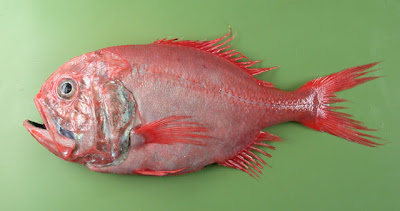

Common names for Opah
Moonfish, Hawaiian moonfish
Other languages for Opah
- French name: Opah
- Italian name: Pesce re
- German name: Gotteslachs
Introduction to Opah
Historically, opah was believed to bring good fortune, and Hawaiian fisherman gave the fish away as a sign of goodwill. However, there was a period when seafood providers were unable to find buyers for the moonfish, which was most likely called for its spherical profile. Opah’s popularity peaked in the late 1980s, when the state of Hawaii began marketing the underused species and American customers developed a desire for more robustly flavored fish. Opah is not always accessible, since the plant does not school and is difficult to harvest in large quantities. While opah is best recognized in the home market as a Hawaiian species, it is distributed globally in tropical and temperate seas. It is often caught as bycatch by longliners fishing for tuna between New Zealand and California, and is also fished off the California coast. When local resources are depleted, opah is imported into the US market mostly from Fiji, Tahiti, and New Zealand. Opah was formerly identified as Lampris regius in scientific literature.
Product profile for Opah
Each opah contains four different sorts of flesh, each of which has a different hue. The delicate loin flesh is a bright salmon-orange color that runs along the backbone from eye to tail. The stringy, less sensitive side meat is the same color as the loin at the top but paler at the bottom. The meat on the cheeks is a dark crimson color. Except for the bright red breastplate flesh, which browns as it cooks. Opah has a solid, fatty texture and a rich, creamy flavor. The flavor is similar to tuna and swordfish, with a distinct but not overwhelming flavor.
Cooking tips for Opah
Chefs like the opah’s large-grain, fatty meat because it can be used in a variety of ways. It also pairs well with bold sauces. The loin produces steak-like fillets that may be grilled, broiled, or sautéed. The flesh from the top loin of an opah makes superb sushi. The remainder is too fibrous to eat raw, but it cooks down to be quite soft.
Nutrition facts for Opah
Calories: 112 Fat Calories: 17 Total Fat: 1.9 g Saturated Fat: N/A Cholesterol: N/A Sodium: N/A Protein: 23.6 g Omega 3: 0.4 g
Primary product forms for Opah
Fresh: Fillets, Loins, Whole Frozen (rarely): Fillets
Global supply for Opah
Australia, Fiji, New Zealand, Tahiti, United States, Iran